While Star Wars is many things to many people, it is, at its heart, a story about a religious revival. If you look at the films chronologically, the stodgy Jedi Order collapses in spectacular fashion over the course of the Prequel Trilogy, leaving a few scattered Force believers looking for purpose in Rogue One, before a trio of Jedi Knights help restore balance in the Original Trilogy. But the Jedi Order Reboot also collapses spectacularly, and, in The Force Awakens and The Last Jedi, we’re back down to a couple of Force users who might be about to bring the religion back a second time.
I’m fascinated by the way the series uses parallels to real-life religious iconography to tell its story, especially how, in Rogue One and The Last Jedi, the filmmakers used some very specific references to create a richer and more inclusive galaxy far, far away.
In a 1999 article in Time, journalist and heroic journeyer Bill Moyers suggested that religion was central to Star Wars’ success, saying, “One explanation for the popularity of Star Wars when it appeared is that by the end of the 1970s, the hunger for spiritual experience was no longer being satisfied sufficiently by the traditional vessels of faith.” George Lucas, having rejected the idea that his films were “profoundly religious” said that he saw his films as “taking all the issues that religion represents and trying to distill them down into a more modern and easily accessible construct” and followed up by saying “I put the Force into the movie in order to try to awaken a certain kind of spirituality in young people—more a belief in God than a belief in any particular religious system. I wanted to make it so that young people would begin to ask questions about the mystery.”
I find this interesting, because the “modern” and “accessible” religion he created is, essentially, Taoism, which is pretty old even for a religion, and one which doesn’t really mention God—at least, not in any anthropomorphic, Western way. What we learn of the Force in the Original Trilogy is fairly vague. Luke is told that the Force is “an energy field created by all living things. It surrounds us and penetrates us; it binds the galaxy together.” He is told by his two masters, Obi-Wan and Yoda, to “use” the Force, and later that the Force is a “powerful ally.” The Force seems benign, but when Luke decides to go to Bespin to rescue his friends, he defends his choice by saying “I feel the Force,” and Yoda snaps that he can’t “control” it. Yoda also explicitly says that Luke will become “an agent of evil” if he bails on his training. So, what gives? Is the Force benevolent, or neutral? Will it push you into doing evil? And how is evil defined in this galaxy, anyway?
The Force and the Tao
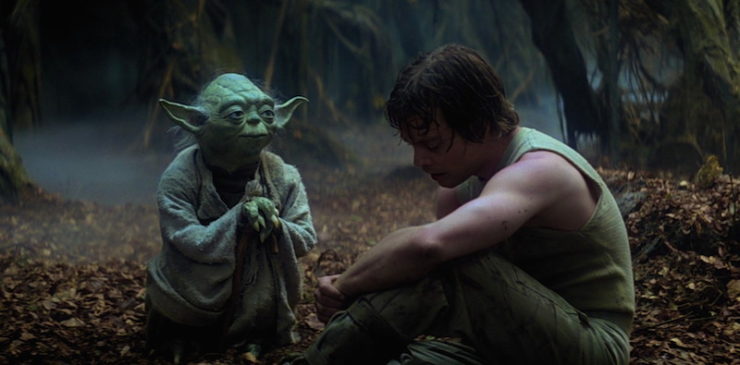
By building ambiguity into the largest religion in his universe, Lucas taps into a sort of streamlined version of Taoism. In the ancient Chinese religion, the Tao is a universal life force that flows around and within all things. Qi (sometimes written as “chi”) is your life force, the flow of your energy, and a “Qi Gong” is a person who has mastered their will in order to have a closer connection to the Tao. The goal in Taoism is “Te,” or acting in concert with the Tao, so you can achieve “Wu-wei,” or non-action—aligning your own will so closely with the Tao that you can act without truly acting. Remain still and passive in the face of life, to see how you can best align yourself with the flow of the universe. This is quite opposite to a typical Western view of life, and it also handily leaves aside ideas about sentience. If the Universe has a “will” or a “flow” does that imply a consciousness working toward a goal?
It’s also extremely similar to Yoda’s view of the Force—as he tells Luke, “You will know [the good from the bad] when you are calm, at peace. Passive. A Jedi uses the Force for knowledge and defense, never for attack.” But the path of the Jedi isn’t just a one-to-one analogue to Taoism. First, the Original Trilogy itself takes a hard turn into Buddhism at one point, and then, as the series has continued, the films have added new iconography and actively worked to disprove some of Yoda’s original teaching.
But Wait, Buddhism!
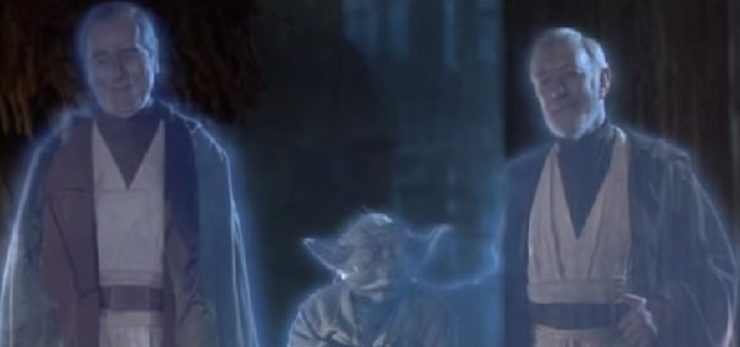
First, with regard to Buddhism: the obvious Taoist equivalent to a Force Ghost would be Xian, enlightened practitioners of Taoism who are either spiritually or physically immortal, and who often exhibit superhuman traits like flying. But I would argue that the Force Ghosts of Yoda and Obi-Wan act more like Boddhisatvas, and that their actions incorporate an aspect of Buddhism into the series to complement the Taoism. Boddhisatvas are Buddhists who, rather than achieving full Buddha-hood, dedicate themselves to the enlightenment of all beings—for example, the Boddhisatva Kṣitigarbha was said to have vowed to help less-enlightened human until all of them could achieve Nirvana, saying, “If I do not go to the hell to help the suffering beings there, who else will go? … if the hells are not empty I will not become a Buddha. Only when all living beings have been saved, will I attain Bodhi.” Yoda and Obi-Wan both seem to keep coming back from their Force One-ness to guide Luke on his journey, presumably so he can help all the beings suffering under the Empire. (They both learned this trick from Qui-Gon Jin, which, nice name, George.) When we do see Anakin’s Force Ghost in ROTJ, he’s appearing to give Luke peace of mind, so the young Jedi can move on with his life and pass on his teachings as Yoda instructed. While this isn’t an exact analogue, Yoda and Obi-Wan only seem to come back for the greater good of the universe, and their actions after physical death are purely spiritual, with none of the superhuman tricks that Xian sometimes perform.
The other shift is simply that there is an ongoing struggle in the films between attachment and non-attachment, and what I would call active versus passive compassion. Yoda and Obi-Wan feel bad for those suffering under the Empire. Obviously, Obi-Wan nearly collapses under the weight of Alderaan’s destruction. But from an old-school Jedi perspective all of these deaths are immaterial—the important thing is defeating Vader and bringing “balance.” But Luke figures something out that Obi-Wan, with his lifetime of baggage, or Yoda, with his commitment to passivity, never could have. As Emmet Asher-Perrin pointed out in this fantastic essay, compassion is Luke’s superpower. He’s not content to sit back and feel bad for others when he can, instead, run off to help them. Given his eventual success, I would argue that the Force is more benevolent than neutral, and that later influences the way he teaches Rey.
A Brief Word About the Prequel Trilogy
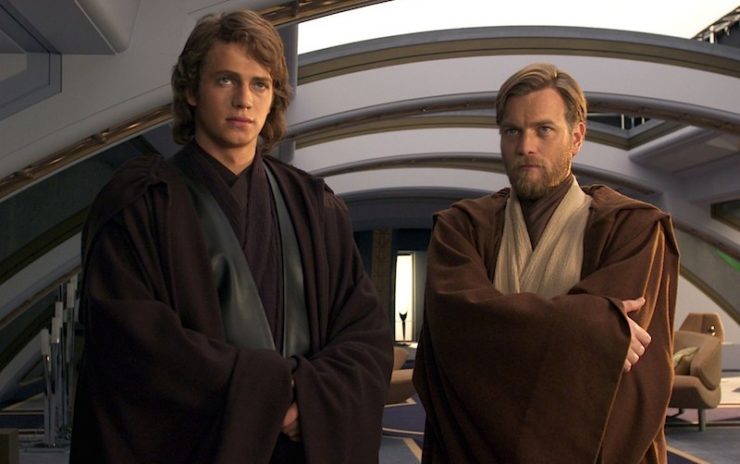
The prequels built the Jedi Order up into a rigid structure—Space Catholicism, or maybe High Church Anglicanism, where small counsels disseminate knowledge according to a strict hierarchy, children are indoctrinated from a young age, and the Jedi stalk about like Space Jesuits, all cool flowing robes and sardonic quips, venturing into distant reaches of the galaxy to act as living representations of the power of the Force.
Jedi Reboot
When the new films came out, one of my greatest hopes was that they would expand on the Jedi faith in-movie-universe, because as cool as some of the Legends Canon is, some of it also far-flung and unwieldy.
The Force Awakens was a bit more vague. Without a Jedi on hand to act as a spiritual leader, we had vague ideas about going on a quest for Luke, and a new generation that doesn’t understand how the Force works. The lightsaber battle between Kylo Ren and Rey seems to prove that not only is the Force alive and well, but that it’s also manifesting in particular people—Finn is able to wield Anakin Skywalker’s lightsaber, but Rey is able to summon it, and the Force manifests strongly enough in her that the saber sails right past Kylo Ren, despite his Skywalker bloodline.
Fine, but it didn’t really build on the old mythology, and it didn’t tell us anything we didn’t already know—since we knew nothing of Rey’s lineage at that point, she very well could have been a Skywalker, a Kenobi, or a Jinn.
The two most recent Star Wars movies, however, gave me everything I wanted and more.
The Holy City of NiJedha

Rogue One did two things that I think are hugely important for Star Wars: first, it got out from under the Skywalkers. Jyn Erso is part of a completely different family, and there’s no indication that her ragtag crew have some giant destiny backing them up—they’re just the ones who were willing to take on a suicide mission to Scarif. It was such a weird sense of relief to watch the movie and know that we were in uncharted territory, and there weren’t any prophecies to be fulfilled or lineages to uphold. Galen Erso’s just a great engineer, and his daughter ended up working on both sides of the law to survive. No more, no less.
But the real depth and excitement for me came in the city of NiJedha. When we see the Holy City it’s something of a backwater—remote, dilapidated, and under tight control by the Empire. We can infer its past, however, because for the first time the films step away from a mélange of “Eastern” mysticism and go west. The City is tight and crowded. Tiny alleys and corridors zig and zag between sun-soaked, baked brick buildings. The Kyber Temple towers over the city, the sun glints off the golden Dome of Deliverance, and the Catacombs of Cadera hover just over the horizon.
We’re in Mecca and Jerusalem now, with Masada a short walk through the dunes.
Hear me out.
Mecca probably predates Islam as a pilgrimage site, but now about 2 million people a year undertake Hajj, the annual pilgrimage to the Al-Masjid Al-Ḥarām—the Sacred Mosque. Standing at the center of the Sacred Mosque is the Ka’aba, and embedded within the Ka’aba’s eastern corner is the Black Stone, an ancient relic that becomes the focus for tawaf, a ritual in which the pilgrim walks counterclockwise around the Stone seven times. Ideally the pilgrim kisses the stone, but because the Hajj can be dangerously crowded, it’s more customary now for people to point to it as they walk. There are many many traditions surrounding the Stone, including that it was embedded in the wall by Muhammed himself, that the Stone dates back to Adam and Eve, and that the Stone used to be white, but has darkened over the centuries from coming in contact with human sin. This is only one part of Hajj, which is a six-day-long event, with specific rituals for each day, but I’m focusing on it because it seems like such an obvious fit with the Kyber Temple.
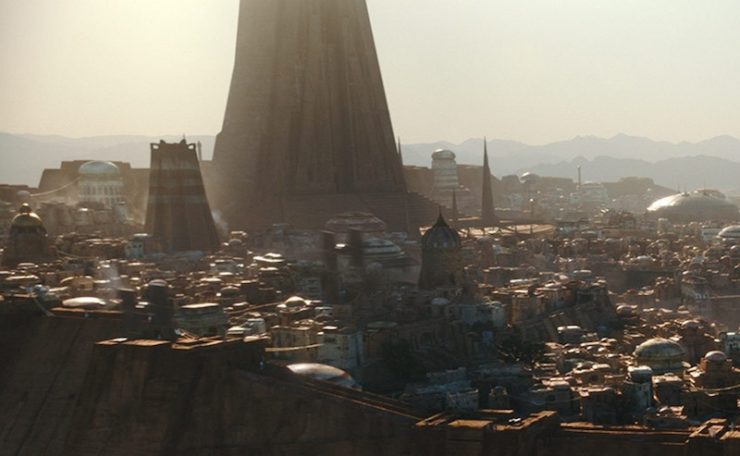
Beyond the alliterative effect of Ka’aba and Kyber, we have large, central structures that house crystals which have been imbued with meaning, and which attract a constant flow of pilgrims. While the Black Stone has many stories about its origin and meaning, Kyber crystals have two distinct functions – one is to power lightsabers, which are the elegant weapon of a civilized age, and the other is to fuel the Death Star, which obliterates everything in its path.
The Dome of Deliverance, featured in the front of the first panorama of NiJedha, recalls the Dome of the Rock:
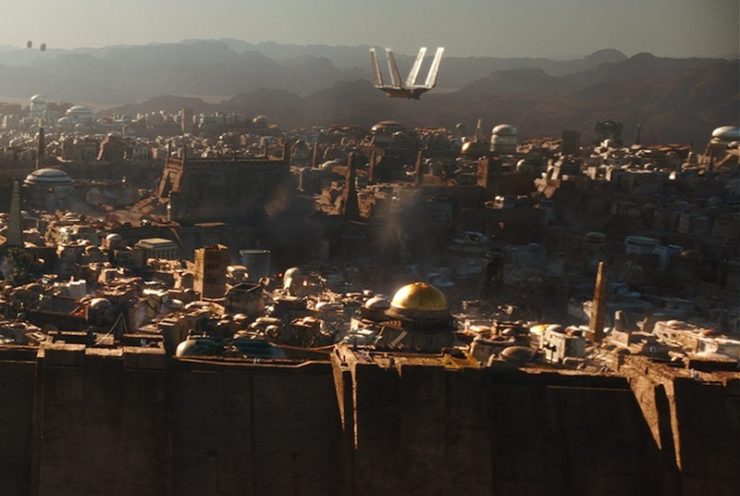
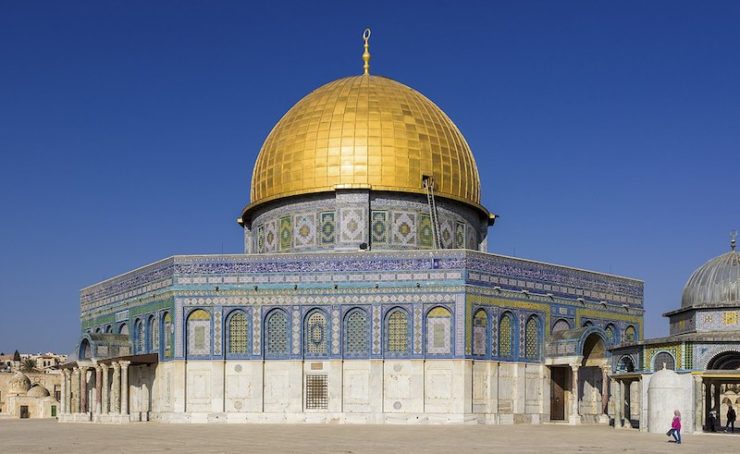
The Dome is a contentious site, important to each of the Big 3 monotheisms. [Deep breath] In Judaism, the Rock within the Dome is thought to be the place where God gathered the dust that was formed into Adam and Eve, and the site of Abraham’s near-sacrifice of Isaac. Historically it was the site of the Second Temple, until the Romans razed it during the First Jewish-Roman War in 70 C.E. The Romans built their own temple, Jupiter Capitolinus, on the site, which remained until 691 C.E. when the new Muslim ruling class replaced it with the Dome of the Rock. The Dome marks the site of Muhammed’s ascension to heaven during his Night Journey, or Isra Mi‘raj—a trip that saw Muhammed meeting with Abraham, Moses, Jesus, and other assorted prophets before being sent ahead to meet with God.
Once we get to Saw Gerrera’s hideout we find another visual reference point. By settling Gerrera’s headquarters in an ancient catacomb, the filmmakers recall several real-world religious motifs: early Christians, in hiding from an unforgiving Roman government; the Dead Sea Scroll writers, living an ascetic, communal life in a series of cliffside caves; and, most strongly for me, Masada.
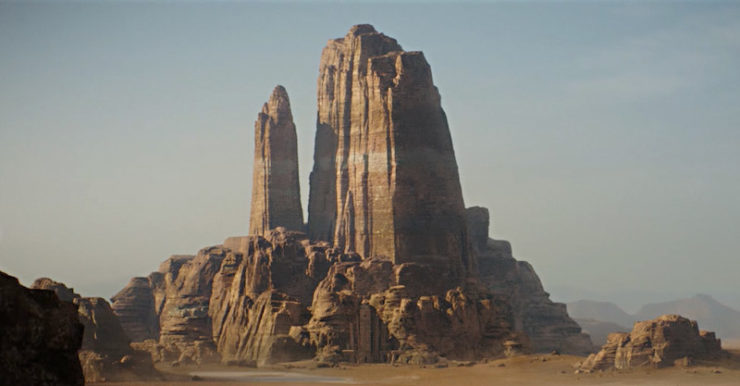
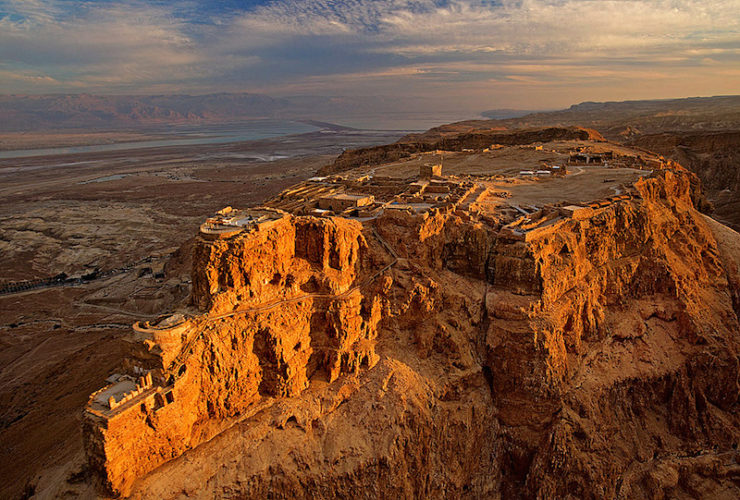
Masada was a fortress built atop a mesa. During the First Roman-Jewish War (66-73 CE) a group called the Zealots mounted a rebellion against Rome, in an attempt to regain Jewish control of Jerusalem. A splinter faction called the Sicarii carried out secret raids and assassinations during the course of the war, and for a time, Roman rule was broken, but then Rome sent more waves of troops in, crushed the rebellion, and destroyed the Second Temple. What was left of the Sicarii walled themselves into the fortress of Masada, and, according to some reports, committed mass suicide rather than surrender to the Romans.
By riffing on these real-life holy sites, Rogue One charges the Star Wars Universe with a sense of history and tradition that builds beautifully into A New Hope. Now when we rewatch the original Star Wars and we hear Han and Tarkin scoff at the Jedi religion, we have physical sites in mind—and we know that they were all destroyed.
Jedha was home to an ancient civilization, said to be the first to study the Force. There was speculation that it was the site of the First Jedi Temple, rather than Ahch-To, and it is home to several different temples and religious orders. It also hosts a near-constant stream of pilgrims, which is where Chirrut Imwe and Baze Malbus come in. As Guardians of the Whills, they traditionally protected the Kyber Temple, but, more importantly, they protected those who traveled to the Temple—of any faith. According to the additional canon books, that includes Jedi, Church of the Force, Brotherhood of the Beatific Countenance, Clan of the Toribota, Church of the Contained Crescent, or anyone else who entered the city with peaceful intentions.
What we have here is an idealized version of the Rome or Jerusalem of the 2nd Century CE, where dozens of types of paganism coexisted with Judaism, emergent Christianity, Buddhist monks, devotees of Mithra, Cynics, Stoics, and plenty of other believers. This vibrant, metropolitan, tolerant city, with all of its jostling faiths, is the first place ever attacked by the Death Star. The first time its own native minerals are used against it, and the kyber crystals, used to make lightsabers which at least ideally were intended as peacekeeping instruments, would now be used in a devastating war machine.
Which leads us into The Last Jedi, which incorporates a particular strain of Christian history to add to Star Wars’ theological Chex Mix.
Space Monks!
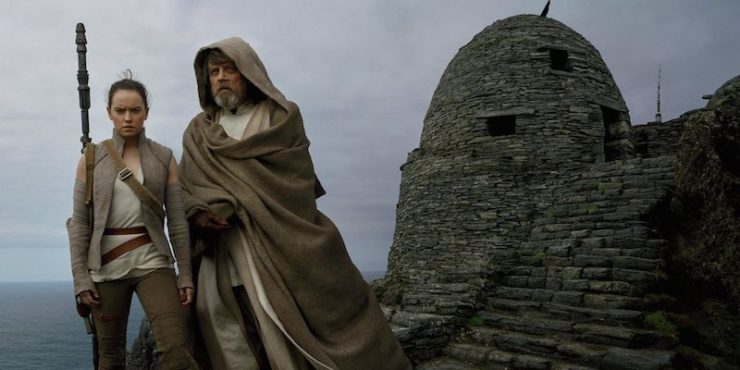
When Rey landed at Ahch-To, I was ecstatic to see that the films were incorporating an eerie Irish island in the SWU. But actually seeing how TLJ used Irish history and the traditions surrounding Celtic Christianity has made my heart grow multiple sizes.
Time for more history! Plenty of the stories that are tied up in “Celtic Christianity” are romanticized hyperbole. I mean this literally: the Romantics loved this idea of an unspoiled Celtic lands, lightly glazed in Christianity but still in touch with their pagan roots. The idea of Celtic Christianity is also popular in some corners of the New Age movement, where people can create a hybrid of Catholicism and paganism and feel that they’re tapping into an ancient unsullied tradition. (This is especially powerful if you’re a feminist, or queer, or trying to find a way to keep your faith in the face of, say, an abuse scandal.) Now in the midst of all the mist and pipes and peat-smoke fires, you’ll find a kernel of truth.
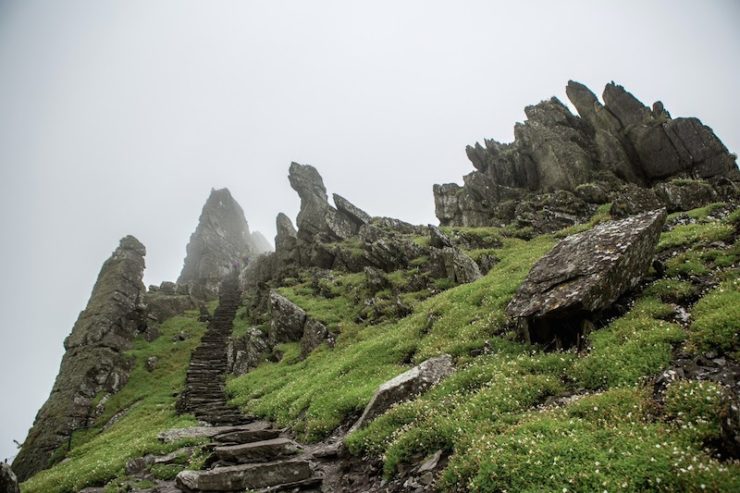
Irish monks did have a particular view of their religion, and in practicing it often adhered to an idea of austerity that was more extreme, and more personally-oriented, that the mainstream world of priests and bishops. Beyond just retiring to an abbey, many Irish and Scottish monks left the large islands entirely to build abbeys on the tiny, craggy islands that circle Western Ireland and northern Scotland. (Several famous monks did this to atone for murder, including Saints Columba and Patrick.) And rather than performing public penance, as was common in most of Europe, Celtic Christians practiced a private, inward-looking form of penance that became the root of the modern version of confession.
Luke fucked up. He really, seriously, fucked up. But rather than make up for it by recommitting to the resistance, or working publicly with his sister to fight the first order, he exiled himself to a monastery, living alone, denying himself comfort, and examining himself constantly for the root of his mistake. (In his training of Rey, Luke emphasizes this sense of interiority far more than Yoda did.) Right there we can see why the island of Skellig Michael and its ancient monastery would be resonant, but then the movie sticks to the theme and plays out a miniaturized sci-fi version of Irish monastic history.
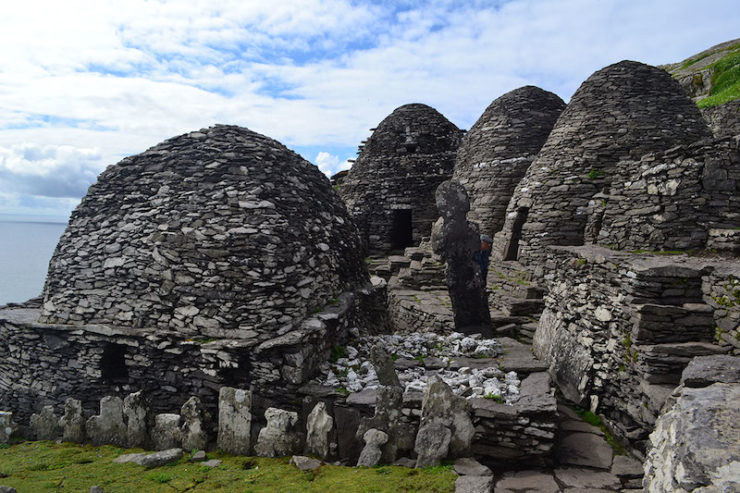
After the fall of Rome and Byzantium, monasteries became decentralized centers of learning, and the strongest of these were in Ireland and Scotland. The remoteness of the islands allowed monks to live quietly copying and illuminating manuscripts without the churning wars that affected continental Europe. Plus for whatever reason “exile for Christ” was extremely popular in Irish and Scottish Christianity. But this was just the beginning. The kicker (historical-religiously-speaking) was that starting in about 560 a monk named Columba traveled to Scotland and founded a monastery on the island Iona to do penance for murdering some people and starting a battle over who got to keep a psalter, and then the right of sanctuary was overridden a couple times, and tl;dr: Columba was almost excommunicated, but was allowed to go into exile instead. Hence, penitential monastery. About 50 years after Columba’s success in converting the Picts to Christianity, and founding several monasteries across Scotland, a monk named Columbanus led a small group across Europe, founding monasteries and inspiring Irish-influenced monastic cells across what is now France, Germany, Belgium, and Switzerland. This cemented a certain reputation Irish monks in particular had for carrying learning back across Europe in a time of unrest.
Meanwhile, back on those remote islands, Irish monks continued living in solitude, working on manuscripts, composing hymns, and hoarding books. There were no large towns in Ireland at that point, so monasteries were the largest cultural centers, and became targets for Viking raids during the 8th and 9th centuries. Vikings would attack, raid monasteries for metalwork, gold, and skalds, and then bolt back to Norway where they could display their treasure, and use it to prove their own power. Vikings working up and down the coast, even striking Skellig Michael, which is here:
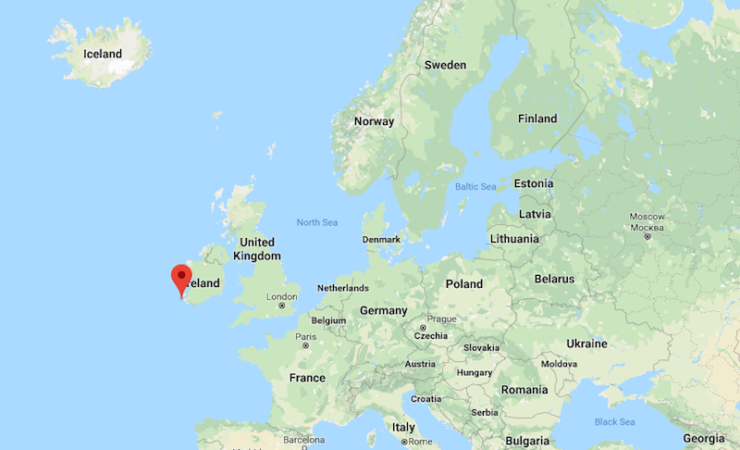
And it’s the filming location of Ahch-To, the planet that Luke has exiled himself to, and the site of the first Jedi Temple.
The Last Jedi director Rian Johnson worked with Skellig Michael—in the cutest example, the Porgs are literally CGI’d over the island’s real puffin population. But he also worked with the history of the island. The Caretakers are aquatic fish-bird hybrids, but they’re also dressed like Carmelite nuns. The all-female group cares for the Temple and structures, have lived on the islands for thousands of years, and merely “tolerate” Luke. They have their own rituals and devotion that have nothing to do with the rest of the people in the film, and have chosen to live in a type of exile, both from their natural home in the sea, and from other, non-Porg creatures.
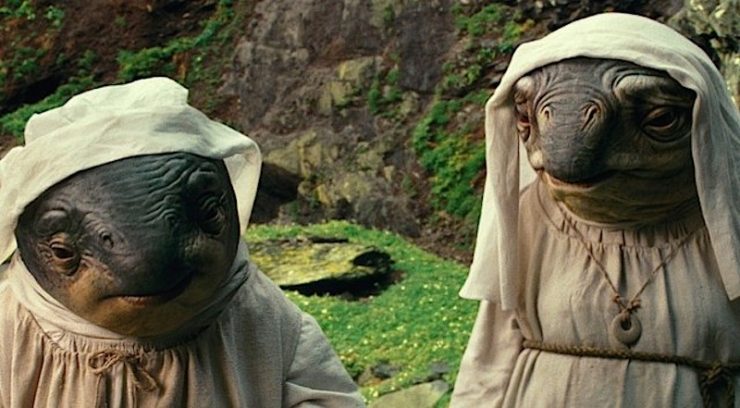
In a deleted scene, Rian Johnson incorporated the island’s history in an even more brutal way. According to Vulture, the scene started with Rey spotting a fire across the island, “and Luke telling her that it’s from a group of bandits that regularly raids and slaughters the Caretakers.” Rey rejects Luke’s demand that she submit to Jedi training by remaining passive, and instead sprints to the fire—to find the Caretakers, Porgs, Chewie, and Artoo dancing around a bonfire, because it was an elaborate test by Luke to make sure she’d put compassion and empathy before rules. Johnson ultimately cut the scene because it makes Luke look like a heartless jerk, but I desperately wish they’d kept it, because not only is the scene itself is a fascinating play on the island’s history—the Vikings did raid the real Caretakers, the Irish monks (with the raids seen as a test of faith, something to be endured)—but also because this moment would have underlined the evolution of the Jedi religion.
Luke’s superpower has always been empathy, and he rises to true heroism when he allows himself to act on that empathy, rather than following the Jedi rules of passivity and non-attachment. By actively testing Rey’s commitment to compassion, and hoping that she’ll snap out of the traditional Master/Apprentice relationship when people are in need, Luke shows that he’s pushing for a new understanding of the Force. One that is divorced from old hierarchies and free of the simplistic binary of Light and Dark that would have had him murder both his father and his nephew.
If we want to take this to its fullest extreme, the monastic Luke and Rey are acting against the wishes of the stodgy Jedi Order we saw in the prequels, much as Celtic Christianity (in the romantic view) stood as the liberal alternative to Roman Catholicism. Luke has rejected the hierarchy and rules of the Jedi Order, and tells his only remaining student that to believe the Force needs the Jedi to keep balance or create “light” in the galaxy is nothing more than arrogance. The Force is there, available to gothy Skywalker scions and broom-wielding stableboys alike. When Rey discovers the Whispering Tree and the Jedi Library, Luke tells her that none of it really matters compared to the Force. And when Yoda shows up for something that can be seen either as an epic troll, or a gift from a teacher to his old student, he burns the tree down and gives Luke no choice but to move on, and let go of his guilt and self-recrimination. I liked this moment, but I was also frustrated in the moment at the dismissal of a literary legacy—but more on that in a moment.
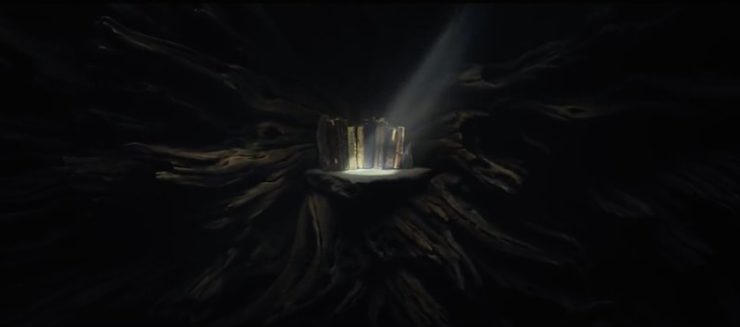
In the end the film unites three of the traditions it’s referenced. After Luke faces down the entire First Order with his laser sword, we learn that he hasn’t really been on Crait at all—he’s been projecting himself across the galaxy from Ahch-To. In this way he has both tapped back into the Force in true Taoist tradition, and stepped into the Boddhisatva role his old Masters occupied. He has sacrificed himself for the good of the many, and he’s done it without actually harming his old apprentice. Rather than succumbing to passivity, or spending any more time on private penance, he lets his compassion lead him back into an active part of the Star Wars drama—but on his own terms. When the film takes us back to Ahch-To, Luke is floating in full lotus position, looking every bit the Quasi-Buddhist Space Monk—he has allowed himself to be part of the flow of the universe again, and that Rey, without even realizing it, has effected the same redemption that Luke achieved for his father Anakin.
The end of the film reveals that Rey has snatched the Jedi writings and taken them with her, somewhat tempering the idea that she should just go with her gut. She’ll have a sense of Jedi history to balance her innate Force sensitivity, and, if need be, she’ll have the written history of the Jedi to draw upon. Rey is now the last monk, working her way through the galaxy, with a few friends and the nearly-lost teachings of an ancient order—Columbanus trekking through Europe with a handful of monks and copies of ancient teachings. But there’s a key difference. She’s not a Skywalker, or a Kenobi, or a Jin. She’s Nothing, Daughter of Nobody. She is the bridge between the aspirations and ideals so meticulously copied and preserved in the Jedi books, and the simple Force sensitivity of the stable boy with his broom. She is the one who can bring the true meaning of the Force to the people.
Leah Schnelbach doesn’t care if the Jedi writings aren’t page-turners, Yoda—she wants to read ’em anyway. Come discuss Jedi theology with her on Twitter!










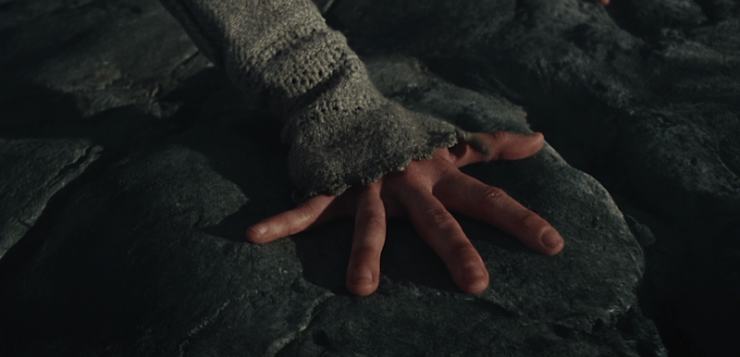
Oh, man! This is awesome. I will read and digest this in more detail later, but thank you for this. As a Christian, an ordaine Presbyterian minister, a comparative religions major in college, and a Star Wars nerd since 1977, this definitely hits so many of my buttons.
I second your wish that the deleted bonfire scene had remained. It doesn’t make Luke, to my mind, seem any more or less heartless than he already does in TLJ (and I don’t think he does – he seems disappointed in himself and hurt and bitter as a response, which is not the same thing), *and* it would have confirmed that Luke realized what the late Republic Era Jedi did not: that compassion and empathy are not antithetical to but essential ingredients of a life lived in harmony with the light side of the Force. We get some official onscreen repudiation of the Late Republic Jedi in Luke’s comment about how they let Darth Sidious take over on their watch, but a dramatization like the one you describe would have been fantastic. Hopefully they filmed it and it will be on the home video release.
Fantastic article!
The Kyber Crystals (in Star Wars) go back to “Splinter of the Mind’s Eye”. And the Whills are mentioned in the prologue to the novelization of Star Wars.
Second @1: Really fascinating article, along with the one you cite. Great stuff!
I love this!
I also wanted more of the Jedi religion!! I’m fascinated by the Whills. I’m also fascinated by the idea/possibility of other Force students that aren’t Jedi and Sith. How do they experience the Force, and what particular rules and traditions do THEY have? You can be on the light side, and not a Jedi (likewise, you can be a Force user too steeped in the dark side, without being a Sith). Are there Jedi oblates, similar to oblates to a Benedictine monastery that apply the *philosophies* to their lives even if they aren’t taking a monk’s vows or living a monk’s life?
Although it’s funny – despite being a religious person – or really, maybe BECAUSE of it – I try not to make too much about ‘real world’ religions in Star Wars or to map them too closely. Star Wars is an interesting (and sometimes convluted) mix of Eastern philosophy and Western archestypes and sometimes it works better than others. Certainly, there are things I find applicable to my faith (I absolutely adore Chirrut and what one can learn about faith/providence/prayerful action from him) but I also know there are things that aren’t going to map perfectly, given that my faith is specifically based on an incarnate/personed God and the Jedi religion is based on a force field of dubious sentience (I also go back and forth on if the Force’s will has any particular morality, or rather, if we should use the Force’s will to determine what the ‘preferred’ morality is. I come from a faith that believes that, as complicated as actual human conditions may be, there is still something objective out there called Good. I am not sure if the Star Wars universe is organized the same way). Also, the dark side (whatever it is) is not really the same at all as something like the devil, a fallen (and lesser) being. But assuredly, my particular ideas about what Jedi and ‘balance’ and the dark side and attachment are, and what the preferred outcomes should be, are viewed through my own faith’s lens.
That said I really enjoyed the different breakdowns of all the traditions he was pulling from here and the ways others might look at this. I personally find some overlap in my own faith with some of the ideas on attachment.
Your description of prequel Jedi as ‘Space Jesuits’ cracked me up. Although I kind of hate the whole “Space Catholicism” of the prequels as it basically exaggerates all the ‘worst’ qualities (not that I really find things like hierarchy/celibacy, etc inherently bad, but they’re portrayed in their worst forms).
My husband studied in Ireland for a few months in college and he loved the little bits of Irish history. And of course for us the huts evoked the old monks due to our own history (and I feel like you’re eliding over the fact that the Vikings DID slaughter the monks. They didn’t just steal/raid/take gold). All that said, I actually with the movie had given us more of a sense that Luke really was engaging in some kind of interior examination of conscience or meditation. There are a few hints here and there – he’s still in his Jedi robes when Rey first finds him – but I think a person could also conclude that he really was just stalled and running from his problems (obviously this has been debated over and over so I won’t bring that here) but NOT in a thoughtful way. I prefer to think he started out that way, but just got lost, and eventually Yoda had to come kick start him again. :)
ONG I WANT THAT DELETED SCENE. It’s funny that they thought it made Luke appear heartless because to me that shows HE STILL GETS IT. It’s kind of reminiscent of my favorite Wheel of Time scenes where Nyneave “fails” her testing (and she does actually fail) because she says ‘screw this detachment thing’ and gets emotional. Yes, I do value detachment but there is a difference between cold deatchment that puts you above everything, and the kind of detachment that comes from peace/trust but still allows you to emotionally engage with the world and appreciate the preciousness of what is in it (and also that you can’t be greedy or entitled or clingy about it – and fwiw, I got all of this from reading books steeped in ‘stodgy’ Roman Catholicism, thankyouverymuch. Guess what, we know what compasison is, it’s not an either/or.).
I had the same mixed feelings about the burning books at the moment in that scene, even as I was loving it, lol. I was so happy to see the books make a re-appearance as well as the hope that Rey will take on the torch. I like to see things evolve instead of just burned down.
I like the expansion of the religion too, and the contrast between Darth Vader’s faith and the contempt of his officers makes it really clear: Palpatine only believes in power, not the Force, and the Empire he has created is explicitly and violently anti-religious. I suspect his ruthless treatment of his pupils (and teacher) wasn’t just Sith orthodoxy–he must have enjoyed killing off both Jedi and Sith.
I know you can only go into so much depth in an article about Star Wars, and I know caveats were included, but the romanticism around Celtic Christianity still itches a bit. It did play an important role in the spread of Christianity through the rest of europe, but the reason why is because ‘Rome’ didn’t really have any power or authority at all at the time. So it’s weird that anyone should play off Celtic vs. Roman traditions as liberal vs. conservative. The authority of Rome was a tenuous and gradual thing built on the politics of a forming Europe.
Which does inform Star Wars I think. The Jedi Order we see must necessarily have formed in concert with The Republic. I don’t know that there is canon about this anymore, but it seems clear that the Senate would have wanted to make sure that this powerful order of militant monks would be kept under civilian authority. The religious order that serves as the military officer caste of the Clone Wars must have developed from some particular need.
From that, I have to push back a little bit still on the notion that Luke is ultimately rejecting the Jedi Order. He himself is pretty clear, twice: in Return of the Jedi, this is what he asserts when he refuses to fight his father: “I am a Jedi.” And he re-asserts this in his final moments as well: “I will not be the last Jedi.”
It’s not in the movies, but from one of the Thrawn books, I recall a scene where someone recognizes Luke as a Jedi, and has expectations of him because of it, positive ones.
That’s something missing in the movies, Han treats it as a hokey religion, Jabba’s group doesn’t have much to think about it, and well, there is the bit in the Phantom Menace where the one Trade federation official is deathly afraid of the Jedi, and trying to convince his boss to treat them seriously.
Just ruminating a little, but I’m not sure what picture Lucas really had of them. And there’s so much in the ancillary works that it’s hard to say what’s what…though that’s not unlike real life either.
And for those curious, there are lots of religious books based on Star Wars, some from the very beginning.
In the OT you got references to the ‘religion’ of the Force. Such as Han’s comment about hokey religions and Vader showing Admiral Motti how he feels about his lack of faith and demonstrates what will die first, the Admiral or the religion. However there was no ‘Force Religion’ to be seen outside it being mentioned.
Then Rogue One comes along and yeaaaa, the religion comes front in center, with temples, temple guards and pilgrims. We now have a foundation for all the talk about hokey religions. In the Last Jedi it gets filled in even more with books and back story.
I always saw the Jedi Order as a group like the Knights Templar’s in our world. Good intentions but becoming corrupt as they became more concerned with their own survival and power. Being wiped out by political powers when they became a hindrance and and no longer useful to that power.
“After the fall of Rome and Byzantium?” Constantinople fell to the Latins in 1204 and then to the Ottomans in 1453. But until those dates the Eastern Romans enjoyed much more continuity of institutions than did folks in the West.
One thing I’m finding interesting in all these post-TLJ articles is the underlying attitude of contempt for the Jedi Order, the way it was. I guess what bothers me about it, is that the Jedi Order depicted in the prequels was already far and away from the ideals the Jedi Order was founded on. Yoda even makes a comment to that effect in Episode 3, speaking about the arrogance of the Jedi Knights in these days.
I suppose it makes a difference to me, because it doesn’t mean that the tenets of the Jedi Order necessarily have to be considered flawed. Rather, I see a group that formed with noble intentions that, incrementally over time, lost sight of those and became the proud, arrogant faux police force we see in the prequels, so full of themselves and their own power that they fail to see the corruption growing right in front of them.
I don’t think that means that the books need to be burned. I’d bet that, any new organization that grew in its place, put in the same circumstances, would have a hard time now following the same path.
Qui-Gon Jinn clearly experiences the Force quite differently from Obi-Wan and Yoda. For the latter the Force is an impersonal medium that acts and reacts on them and all living beings, and that one works to live in harmony with. Qui-Gon on the other hand has a personal relationship with the Force. For him it is a intelligence that has a voice that he listens for and obeys. Presumably that is the difference between Living Force Jedi and the rest. In Real World terms Qui-Gon’s perception is far closer to Western ideas of God than Yoda and Obi-Wan’s.
I see no necessity to choose one perception above the other or say one is right and the other is wrong. IMO there’s no reason why both cannot be accepted.
@4/Lisamarie – It’s funny that they thought it made Luke appear heartless because to me that shows HE STILL GETS IT.
Yes. You said it much more succinctly than I did!
@9/thomasfoster – I think you’re right. And, fortunately, the books were not burned. I hope we see them revisited in Episode IX. Perhaps Rey will see something in them that Luke did not (if he read them at all, as Yoda’s comments to him suggests Luke did not), just as people in religious traditions can find seeds of renewal and reformation in their own sacred texts (sometimes, if accrued layers of reverence and received wisdom and traditional interpretation don’t get in the way. You mention Yoda in the prequels – he said, in Ep III, “a prophecy that misread may have been.” Maybe Rey will read the prophecy differently — I hesitate to say “correctly,” but perhaps in a way relevant to where the Galaxy Far Far Away now finds itself).
@@.-@. They’re arguably-canon now (until nailed down, I count them as “up for consideration”), but there were plenty of non-Jedi Force traditions in the EU. My favourites were Ewok magic (which was more “western fantasy magic,” with shades of generic New Ageism), the Aing-Tii Sanhedrin (who described the Force as a “rainbow,” rather than simply Light or Dark, and saw it as carrying messages from their gods directing them on quests), and Dathomiri Allyan magic (as opposed to the Nightsister magic seen in The Clone Wars –the Allyan tradition rejected the Light/Dark dichotomy, saying that the Force was influenced by the wielder, rather than the other way around).
I have a soft spot for the Aing-Tii. But I’m more familiar with them as they originally appeared in the Darkstryder adventure series for the WEG Star Wars RPG. They were inscrutable aliens with unarmed but supertough ships who traveled through hyperspace without hyperdrives; they almost never communicated with other species, but were known to (apparently) randomly ram ships from time to time. Zahn was involved with the product, and I think he was responsible for drawing them out into the novels.
Buddhism:
Qui Gon Jinn, in the Phantom Menace has a philosophical conversation with Obi Wan almost as soon as the film begins, amounting to something like this “don’t center on your anxieties for the future, which are illusions of your mind, live in the present moment, which is not illusory”.
Buddhism/Christianity:
Let he who is without sin, cast the first stone. The Jedi protect life, above all, and the entire message of The Last Jedi, is that the real battle is between the darkness of entropy and death, vs. the respect for all life to exist. Wars fought to destroy an ideology are inherently corrupting, and actions taken to save lives are inherently edifying. Or as Yoda says “a Jedi uses the Force for knowledge and defense, never for attack”.
Taoism/Buddhism:
The Jedi Order of the Prequels becomes dogmatic out of fear for the future. The fear another Great Schism, so are constantly trying to follow taboos surrounding personal relationships, and are remote, not offering compassion. Qui Gon Jinn however lives in the present moment, does what naturally seems compassionate in the here and now, and trusts his instincts. His philosophy is eventually vindicated, and Yoda and Obi Wan spend their exile coming to terms with it.
The spiritual/religious aspects of Star Wars can be easy to overstate, but I do feel that the decision to structure ANH around the monomyth plus a smattering of Eastern philosophy is almost certainly what changed it from another sci-fi flick into something with more staying power. Decisions by Lucas, his collaborators, and successors to import other philosophical/religious elements in each successive film built on that nicely
I do so enjoy analyzing works to see the various real-world concepts that were used for inspiration, and how creators can use them to help provide structure to a story and/or convey story elements without the need for extensive infodumps via dialogue or narration (which is especially important for film & TV). It can serve as a reminder that often the originality and resonance of a work lie not in any of its particular ideas, but in how previous concepts have been selected, combined, and arranged into something new.
You say “While the Black Stone has many stories about its origin and meaning…” With respect, the Black Stone of Mecca is physically a meteorite. It fell to Earth from the spaces between the planets. It has no meaning. They are kissing a meteorite. End of.
Hey, I am glad that someone has addressed the “elephant in the living room”. When I was in SEMINARY [ ak! A 61 year old retired minister who’s a scifi nerd!] I learned that A New Hope was based on a book by the late Rev. Dr. Joseph Campbell: A Hero with a Thousand Faces. It’s one of the reasons I loved the first three movies, and, until this reboot, have ignored the series.
And anyone who is at all familiar with A New Hope, can see it’s conclusions/mirroring in The Last Jedi
@17 – I think you’re missing the point of the article. The English language is the sort that follows other languages down a dark alleyways and shakes them down for loose bit of grammar. The Star Wars mythology, right from the start, does much the same with tropes of various cultures, mythologies and religions. Star Wars (and the article) isn’t interested in the “truth”. It doesn’t matter that (from your point of view) they’re kissing a meteorite. Star Wars is interested in the stories people tell each other, and what it can “acquire” from those stories to enrich itself (after filing off the serial numbers, obviously). It seems to me that the point of the article was to do some fancy CSI shenanigans to see those serial numbers, so we can track where it got it’s fancy furnishings from.
It’s funny you close with “end of”, because Star Wars is bored by facts. It’s only after you move beyond the facts to the stories that it becomes interesting. That’s where it all begins. :)
I have some questions about the iconography in TLJ.
What’s the significance of the dead tree that houses the library of the Jedi? Why 5 branches? Did it remind anyone else of a large chair?
The meditation pool (for want of a better term) with the mosaic: what did it depict? The division between light and dark is obvious, as well as invoking yin and yang, but there seemed to be more to it that I’m missing.
The cliffe opening that faces the setting suns seems significant as well. IRL, don’t most Temple openings face the rising sun? And is the mediation plinth common?
East West orientation was standard in Western Civilization, not sure about other traditions. In this case I imagine it was symbo!ic of the Jedi ending.
Celtic Christianity spread widely over Wales, mostly in the Llan system which survives in place names. Also in Cornwall, where you can discover a new local saint every few miles.
In TLJ, General Holdo wishes the rebel fleet, “God speed.” Which God, I wonder.
The religion in Star Wars also seems to be reminiscent of Zoroastrianism, with its balance between light and darkness.
20, I don’t know that it means anything, but there are 5-way systems in some religions.
Hitchens was right, religion poisons everything, even Star Wars.
@24 Fundamentalism is what poisons everything – whether fundamentalist atheism, Christianity or any other form that it takes.
Great article! And a great discussion, too!
Heyo, Veteran of Imrama here. (Early Medieval Irish sea pilgrimages, like St Brendan).
I havent been to Skellig Michael, (I know people who have) But I went somewhere similar….North Rona. So I know what it feels like. These guys (some were female) were TOUGH. (Read a book called Island Years, by Frank Fraser Darling for a description of overwintering).
BTW, you can land the Falcon on North Rona (or St Kilda) if you like, (a twin engined bomber made an emergency landing there in the war) but Skellig Michael? Suspension of disbelief dead!
I think the old monks would be chuffed to be reimaged as Space Warrior Monks….They had read the classics after all.
For me the SW religion would be Cosmicism (Finding a place for yourself in the Universe. Carl Sagan professed atheism, but read his one foray into fiction, Contact, and its obvious he is searching for something). or Mohism. (Think Taoism and science).